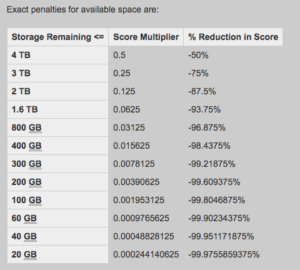
First of all, I’m a fan of Siacoin. The team appears upfront and transparent. They’ve had a working product for a long time now and the concept is good, monetising spare hard disk space. But it’s not until you go through the process that you really understand some of the subtleties of Siacoin. The main one being, it’s not really designed for the average Joe to rent a few Gb of disk space and make some money. It’s for the professionals and here is why.
When I heard of monetising spare disk space, I quickly started hunting for the old spare hard drives I had lying around. A few 2.5 40Gb from old laptops 5 years ago, an 80Gb and a 160Gb. Great. I downloaded the client and then discovered I needed to buy Siacoin to make Siacoin. This is because wannabe hosters like myself need to put some Siacoins on the line because if I don’t keep my hard drives running, my customers (renters) will lose their files they store with me. This is called collateral and that’s fair.
So I got set up with some Siacoins and managed to connect to the network and make 40Gb + 40Gb + 80Gb + 160Gb =320Gb available. What I then learnt is that you get given a score based on various factors. Your downtime, how long you’ve been hosting for, the amount of spare disk space you have and a bunch of other parameters. The effect is that to be attractive to renters (ie make money) you need to have a high score. This is where subtlety #1 comes in.
Subtlety #1: Not spare storage, but heaps of storage
I need to have more than 4Tb to get the maximum bonus points. Sia reverses it and penalises you. To put it another way, I need more than 4Tb to NOT be penalised.

If you look at all the other hosters, they have 9Tb, 10Tb even 30Tb up for grabs! These guys are not your average Joe.

Ok. So you don’t have a spare 4Tb lying around but you still want to play the game, and besides, you’re not aiming to be ranked #1. Somewhere in the top 100 might be fine as well.
You get points for being an old hat. What this means is that if you’ve been hosting for more than 41 days then you are not penalised so you can just wait it out here.

If you have the latest version of the Sia wallet you won’t be penalised and you can set some competitive storage contract prices also but these drives of mine were 5+ years old already. What happens when they crap out?
Subtlety #2: Hard drive lifetime
Hard drives have a limited lifetime. They can only spin so many hundreds of thousands of times before they give up and die. If you are hosting with SSD you’re doing much better than a lot of us! With my old hard drives, I’d be lucky if I get another 12 months out of them spinning 24 x 7. The reason why they have lasted 5+ years and that they haven’t been in continuous use. Having my computer always on and hard drives always spinning, I have to get ready to deal with what happens when it dies because if it dies before my contract ends I will lose my collateral. Note: When I first host files I specify a duration in weeks that I will host for which forms part of my contract with the renter.
I had never thought if this initially. My research to solve this problem led me to subtlety #3, having a backup system.
Subtlety #3: Backing up the data
I had to learn about RAID. Redundant Array of Independent Disk. There are several configurations I can set up my hard drives in to help ensure that if one hard drive fails, there is a back up so that my customers information is not lost. I can mirror my drives, I can stripe them or I can mirror and stripe them. If you don’t know what I’m talking about, this is my point exactly. The average person is not really interested in learning about RAID. It’s very important as a host though which is why Siacoin is not for the average Joe. Besides, when you create a RAID configuration your capacity can half!
Speaking of replacing hard drives and having backups, what about when you trip a circuit in your house? This brings me to subtlety #4, always on.
Subtlety #4: Always on
If you blow a fuse at home and your computer turns off, you need to be around to turn it back on. To get around this you can use a UPS (Uninterruptible Power Supply). Who has one of these lying around? Presumably not the average Joe! Power surges during electrical storms, unexpected power cuts from your power company, these things need to be considered. Otherwise you’ll get hit with an uptime penalty for being down.

If you do lose power accidentally, there is a chance that some files might get corrupted. This is where subtlety #5 comes in. Technical knowledge and patiences.
Subtlety #5: Technical knowledge
If a file does get corrupted because the Sia client was not gracefully shut down you’re in for a lot of strife. You’ll get weird errors like
“Could not open the storage manager: error while loading the WAL at startup: failed to recover WAL: walFile metadata mismatch: error reading WAL metadata: invalid character ‘\x00’ looking for beginning of value”.
You will have to search for possible solutions and if you can’t, you’ll end up synchronising the entire blockchain again just so the wallet can open. This will take about 2 days and then restore each file one by one in order to not lose the contracts you had. This takes a lot of time and trial and error all the while knowing that you’re being penalised for being “offline”.
Summary
It’s great to try and monetise excess or spare hard disk drives lying around but realistically you need to have a professional set up to ensure you have a good ranking so that renters will pick you as a host and have the capability to replace hard drives when they fail because they will and also not to lose customers data. Also looking at those professional host, they are offering 30Tb which tends to indicate they are setup to be professional hosters with NAS storage and banks of xTb hard drives.
It is important to be able to have backups and not lose customer files so all these skills and setups are definitely required. It just means that the average Joe will have to learn this or professional hosters will dominate the field.
